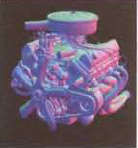Chapter 9. Integrating Render Passes
"Most people have a mental model of a composite that looks like [a] stack of layers."

Compositing CG elements has its own unique challenges. Of these, the fact that CG is often divided into multiple layers leads to a different compositing workflow than may be present with live-action footage. The process becomes even more complicated when each layer is broken into specific render passes. Common render passes include beauty, diffuse, specular, and shadow. More complex passes, such as depth, motion vector, surface normal, and RGB lights, are not unusual. Although render passes increase the compositor's ability to fine-tune, they also require more complex layer stacks and node networks. With the tutorials in this chapter, you'll have the chance to practice compositing CG that is broken into numerous render passes. At the same time, you'll have the opportunity to relight a CG shot with a single RGB light pass.

Dividing a CG Render
When a shot is animated in a 3D program on a professional production, it is rarely rendered out as is. Instead, the shot is divided into layers and/or render passes. Dividing a shot into layers allows key elements—including characters, backgrounds, shadows, ...
Get Professional Digital Compositing: Essential Tools and Techniques now with the O’Reilly learning platform.
O’Reilly members experience books, live events, courses curated by job role, and more from O’Reilly and nearly 200 top publishers.

